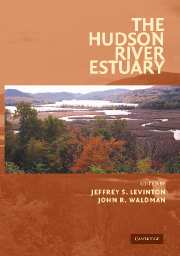Book contents
- Frontmatter
- Contents
- Preface
- List of Contributors
- The Hudson River Estuary
- 1 The Hudson River Estuary: Executive Summary
- GEOLOGICAL, PHYSICAL, AND CHEMICAL SETTING OF THE HUDSON
- PRIMARY PRODUCTION, MICROBIAL DYNAMICS, AND NUTRIENT DYNAMICS OF THE HUDSON
- HUDSON RIVER COMMUNITIES, FOOD WEBS, AND FISHERIES
- 12 Larval Migrations Between the Hudson River Estuary and New York Bight
- 13 The Diadromous Fish Fauna of the Hudson River: Life Histories, Conservation Concerns, and Research Avenues
- 14 Fisheries of the Hudson River Estuary
- 15 The Role of Tributaries in the Biology of Hudson River Fishes
- 16 Ecology of the Hudson River Zooplankton Community
- 17 Submersed Macrophyte Distribution and Function in the Tidal Freshwater Hudson River
- 18 Long-Term and Large-Scale Patterns in the Benthic Communities of New York Harbor
- 19 The Benthic Animal Communities of the Tidal-Freshwater Hudson River Estuary
- 20 Tidal Wetlands of the Hudson River Estuary
- 21 Alien Species in the Hudson River
- CONTAMINANTS AND MANAGEMENT ISSUES OF THE HUDSON RIVER ESTUARY
- Index
- Plate section
- References
17 - Submersed Macrophyte Distribution and Function in the Tidal Freshwater Hudson River
Published online by Cambridge University Press: 06 January 2010
- Frontmatter
- Contents
- Preface
- List of Contributors
- The Hudson River Estuary
- 1 The Hudson River Estuary: Executive Summary
- GEOLOGICAL, PHYSICAL, AND CHEMICAL SETTING OF THE HUDSON
- PRIMARY PRODUCTION, MICROBIAL DYNAMICS, AND NUTRIENT DYNAMICS OF THE HUDSON
- HUDSON RIVER COMMUNITIES, FOOD WEBS, AND FISHERIES
- 12 Larval Migrations Between the Hudson River Estuary and New York Bight
- 13 The Diadromous Fish Fauna of the Hudson River: Life Histories, Conservation Concerns, and Research Avenues
- 14 Fisheries of the Hudson River Estuary
- 15 The Role of Tributaries in the Biology of Hudson River Fishes
- 16 Ecology of the Hudson River Zooplankton Community
- 17 Submersed Macrophyte Distribution and Function in the Tidal Freshwater Hudson River
- 18 Long-Term and Large-Scale Patterns in the Benthic Communities of New York Harbor
- 19 The Benthic Animal Communities of the Tidal-Freshwater Hudson River Estuary
- 20 Tidal Wetlands of the Hudson River Estuary
- 21 Alien Species in the Hudson River
- CONTAMINANTS AND MANAGEMENT ISSUES OF THE HUDSON RIVER ESTUARY
- Index
- Plate section
- References
Summary
abstract In the tidal freshwater Hudson River submerged aquatic vegetation (SAV) occupies on average 6 percent of the river area with much greater coverage in the mid-Hudson (Kingston – Hudson) and much lower areal coverage south of Hyde Park. The native water celery (Vallisneria americana) is by far the predominant species in terms of areal coverage but the invasive water chestnut (Trapa natans) attains a higher standing stock on a smaller area. Vallisneria is light-limited in all but the shallowest depths and produces sufficient oxygen to maintain super-saturated conditions in some plant beds for a large proportion of summertime daylight hours. SAV supports abundant and diverse invertebrate and fish faunas with distinct differences between Vallisneria and Trapa. Turbidity in Vallisneria is frequently greater than in the main channel in contrast to the baffling and enhanced sediment deposition generally expected in plant beds. Overall, SAV plays several important and unique roles in shaping the habitats and ecosystem functioning of the Hudson River.
Introduction
Submersed aquatic vegetation (SAV) plays a critical role in many aquatic systems, contributing to primary productivity, nutrient cycling and sediment dynamics, as well as providing important habitat for fishes and invertebrates (Rozas and Odum, 1987; Heck et al., 1995). Aquatic macrophyte communities are some of the most productive natural ecosystems and have been found to support numerous and diverse wildlife populations (Dennison et al., 1993; Kemp, Boynton, and Twilley, 1984).
- Type
- Chapter
- Information
- The Hudson River Estuary , pp. 230 - 241Publisher: Cambridge University PressPrint publication year: 2006
References
- 6
- Cited by

